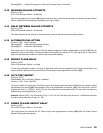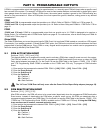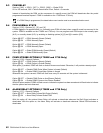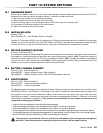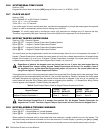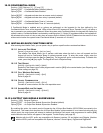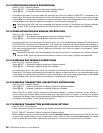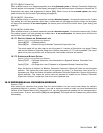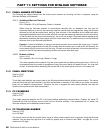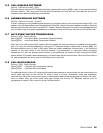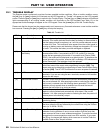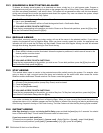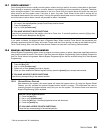
46 REFERENCE & INSTALLATION MANUAL
10.13 PRINTER BUS MODULE SUPERVISION
Section [129]: General Options
Option [8] OFF = Printer Bus Module Supervision Disabled (default)
Option [8] ON = Printer Bus Module Supervision Enabled
By enabling this option, the control panel will supervise the Printer Bus Module (APR3-PRT1) connected to the
Spectra bus. This means that whenever the Printer Bus Module is disconnected or is not communicating with the
control panel, the control panel will attempt to transmit the Module Fault report code programmed in section [210]
and the Module Loss Failure will appear in the keypads’ Trouble Display (see page 50).
Modules with the APR- prefix are compatible with Spectra (versions 2.0 and higher) and Digiplex. Modules
with the APR3- prefix are compatible with Spectra( versions 2.0 and higher), Digiplex and DigiplexNE.
10.14 ZONE EXPANSION BUS MODULE SUPERVISION
Section [129]: General Options
Option [4] OFF = Zone Expansion Bus Module Supervision Disabled (default)
Option [4] ON = Zone Expansion Bus Module Supervision Enabled
By enabling this option, the control panel will supervise the 4- or 8-Zone Expansion Bus Module (SPC/APR3-ZX4 or
SPC/APR3-ZX8) connected to the Spectra bus. This means that whenever the Zone Expansion Bus Module is
disconnected or is not communicating with the control panel, the control panel will attempt to transmit the Module
Fault report code programmed in section [210] and the Module Loss Failure will appear in the keypads’ Trouble
Display (see page 50).
Modules with the APR- prefix are compatible with Spectra (versions 2.0 and higher) and Digiplex. Modules
with the APR3- prefix are compatible with Spectra( versions 2.0 and higher), Digiplex and DigiplexNE.
10.15 WIRELESS BUS MODULE SUPERVISION
Section [129]: General Options
Option [5] OFF = Wireless Bus Module Supervision Disabled (default)
Option [5] ON = Wireless Bus Module Supervision Enabled
By enabling this option, the control panel will supervise the Wireless Bus Module (SPC-319) connected to the
Spectra bus. This means that whenever the Wireless Bus Module is disconnected or is not communicating with the
control panel, the control panel will attempt to transmit the Module Fault report code programmed in section [210]
and the Module Loss Failure will appear in the keypads’ Trouble Display (see page 50).
10.16 WIRELESS TRANSMITTER LOW BATTERY SUPERVISION
Section [129]: General Options
Option [6] OFF = Wireless Transmitter Low Battery Supervision Disabled (default)
Option [6] ON = Wireless Transmitter Low Battery Supervision Enabled
When option [6] in section [129] is enabled and the battery voltage of a wireless transmitter (motion detector or
contact switch) has dropped below recommended limits, the control panel will attempt to transmit the Wireless
Transmitter Low Battery report code programmed in section [210] and the Wireless Transmitter Low Battery Failure
will appear in the keypads’ Trouble Display (see page 50).
10.17 WIRELESS TRANSMITTER SUPERVISION OPTIONS
Section [132]: Zone Options
Please note that the Supervision Option on the 900MHz Wireless Bus Module must be enabled (see section 10.15).
[7] OFF / [8] OFF: Supervision Failure Recognition Disabled (default)
When a tamper occurs on a wireless transmitter zone in a disarmed system, the control panel will display the zone
as open in the keypad display, but will not generate an alarm. When it occurs on in an armed system, the control
panel will follow the zone's Alarm Types setting (see page 24). This option is not permitted on UL systems.




